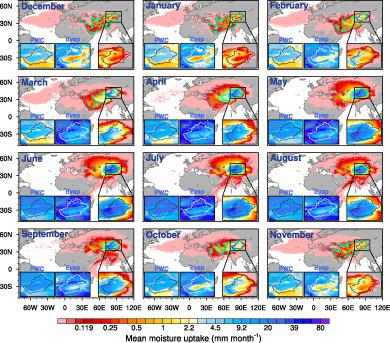当前位置:
X-MOL 学术
›
Int. J. Climatol.
›
论文详情
Our official English website, www.x-mol.net, welcomes your feedback! (Note: you will need to create a separate account there.)
Lagrangian simulations of moisture sources for Chinese Xinjiang precipitation during 1979–2018
International Journal of Climatology ( IF 3.9 ) Pub Date : 2020-05-27 , DOI: 10.1002/joc.6679 Shibo Yao 1 , Dabang Jiang 2, 3, 4 , Zhongshi Zhang 1
International Journal of Climatology ( IF 3.9 ) Pub Date : 2020-05-27 , DOI: 10.1002/joc.6679 Shibo Yao 1 , Dabang Jiang 2, 3, 4 , Zhongshi Zhang 1
Affiliation

|
In this study, the Flexible Particle Dispersion Model (FLEXPART) is employed to simulate the trajectories of global air parcels from March 1979 to February 2018 to analyse the moisture sources of precipitation over Xinjiang in China. The results show that more than 90% of the moisture can be tracked when the backtracking time is set to 10 days. There are three similar moisture transport paths in winter and summer, namely, the Mediterranean–Caspian Sea–Balkhash Lake path, the Eastern European Plain–Western Siberian Plain–Balkhash Lake path, and the Arabian Peninsula–Iranian Plateau–Pamir Plateau path. Besides, there is one more path in summer: the Indian Ocean–Indian Peninsula–Pamir Plateau. The paths of moisture transport in spring (autumn) are similar to those in winter (summer). In summer, the contribution rate of Xinjiang itself and Central Asia accounts for more than 80%, among which the local contributions account for 52%. In the other three seasons, Xinjiang, Central Asia, North Africa–Arabian Peninsula, and South Asia are the main sources of moisture. The contribution rates of moisture uptake in the source regions other than Central Asia vary greatly with the seasons. The interannual variation of contribution rate to precipitation of each source region is limited. Regionally, the moisture source distribution for southern Xinjiang resembles those of the whole Xinjiang; for the northern Xinjiang, the contribution of Central Asia becomes more important.
更新日期:2020-05-27


























 京公网安备 11010802027423号
京公网安备 11010802027423号